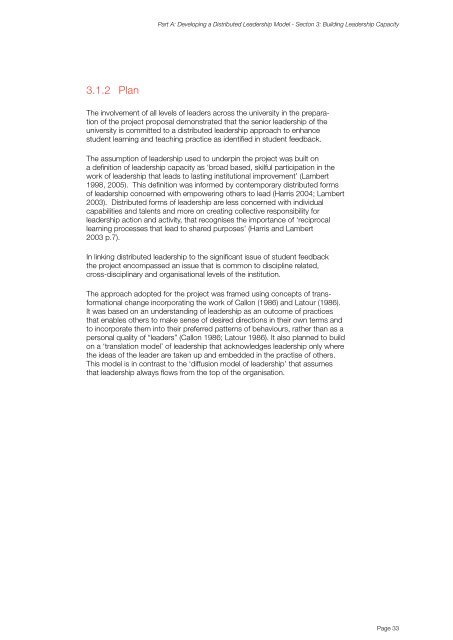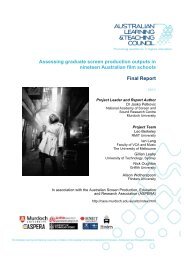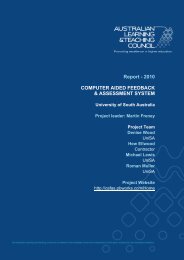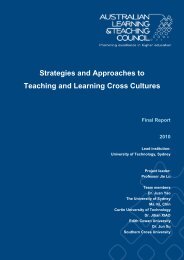student feedback and leadership - Office for Learning and Teaching
student feedback and leadership - Office for Learning and Teaching
student feedback and leadership - Office for Learning and Teaching
Create successful ePaper yourself
Turn your PDF publications into a flip-book with our unique Google optimized e-Paper software.
Part A: Developing a Distributed Leadership Model - Secton 3: Building Leadership Capacity3.1.2 PlanThe involvement of all levels of leaders across the university in the preparationof the project proposal demonstrated that the senior <strong>leadership</strong> of theuniversity is committed to a distributed <strong>leadership</strong> approach to enhance<strong>student</strong> learning <strong>and</strong> teaching practice as identified in <strong>student</strong> <strong>feedback</strong>.The assumption of <strong>leadership</strong> used to underpin the project was built ona definition of <strong>leadership</strong> capacity as ‘broad based, skilful participation in thework of <strong>leadership</strong> that leads to lasting institutional improvement’ (Lambert1998, 2005). This definition was in<strong>for</strong>med by contemporary distributed <strong>for</strong>msof <strong>leadership</strong> concerned with empowering others to lead (Harris 2004; Lambert2003). Distributed <strong>for</strong>ms of <strong>leadership</strong> are less concerned with individualcapabilities <strong>and</strong> talents <strong>and</strong> more on creating collective responsibility <strong>for</strong><strong>leadership</strong> action <strong>and</strong> activity, that recognises the importance of ‘reciprocallearning processes that lead to shared purposes’ (Harris <strong>and</strong> Lambert2003 p.7).In linking distributed <strong>leadership</strong> to the significant issue of <strong>student</strong> <strong>feedback</strong>the project encompassed an issue that is common to discipline related,cross-disciplinary <strong>and</strong> organisational levels of the institution.The approach adopted <strong>for</strong> the project was framed using concepts of trans<strong>for</strong>mationalchange incorporating the work of Callon (1986) <strong>and</strong> Latour (1986).It was based on an underst<strong>and</strong>ing of <strong>leadership</strong> as an outcome of practicesthat enables others to make sense of desired directions in their own terms <strong>and</strong>to incorporate them into their preferred patterns of behaviours, rather than as apersonal quality of “leaders” (Callon 1986; Latour 1986). It also planned to buildon a ‘translation model’ of <strong>leadership</strong> that acknowledges <strong>leadership</strong> only wherethe ideas of the leader are taken up <strong>and</strong> embedded in the practise of others.This model is in contrast to the ‘diffusion model of <strong>leadership</strong>’ that assumesthat <strong>leadership</strong> always flows from the top of the organisation.Page 33
















